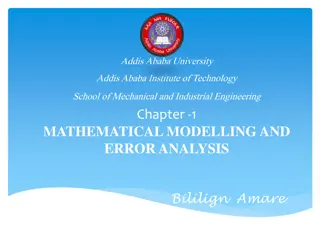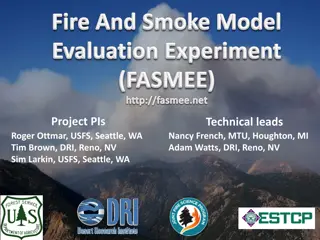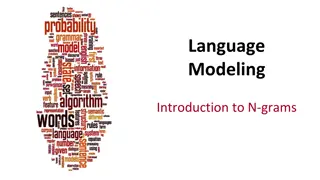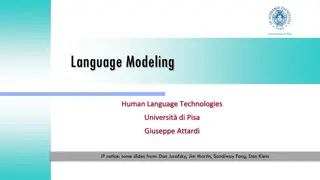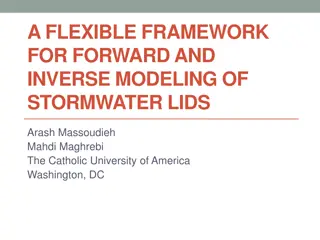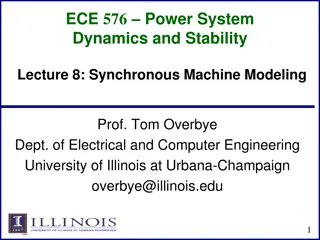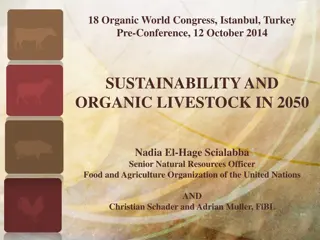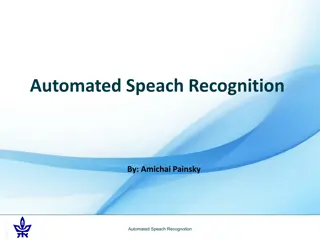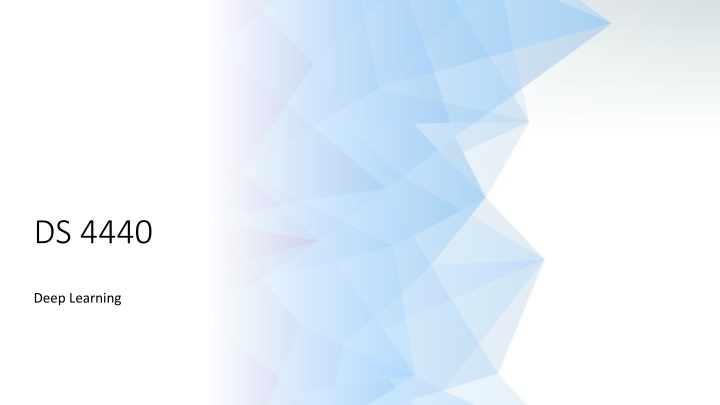
Exploring Language Modeling for Generative Goal in Deep Learning
Discover the potential of language modeling in generating high-dimensional data and the concept of generative goals in deep learning. Explore workshops on interpretability experiments and understand the algorithmic process behind small language models creating probabilistic distributions.
Download Presentation

Please find below an Image/Link to download the presentation.
The content on the website is provided AS IS for your information and personal use only. It may not be sold, licensed, or shared on other websites without obtaining consent from the author. If you encounter any issues during the download, it is possible that the publisher has removed the file from their server.
You are allowed to download the files provided on this website for personal or commercial use, subject to the condition that they are used lawfully. All files are the property of their respective owners.
The content on the website is provided AS IS for your information and personal use only. It may not be sold, licensed, or shared on other websites without obtaining consent from the author.
E N D
Presentation Transcript
DS 4440 Deep Learning
Weekend Workshop Weekend workshop on how to do interpretability experiments using https://nnsight.net/ - could be one option for a project. (Run by Dmitry, Koyena, Jaden) This Saturday 1pm Ryder hall sign up: https://bit.ly/nns-workshop
Language modeling Structuring p(x) to model a sequence
Generative goal: models that can create X is high-dimensional data We want to model big outputs P(X) .... in contrast to classifiers that modeled big inputs P(Y | X) X = a whole paragraph (or image video, audio, etc) Y = label
An example small language model Suppose this is the full set of things that my chatbot can say randomly: Make things well Make it work Make it go Let it work Let me go Let me see Make things work Make things work Let it go Let it go A probability distribution
An example small language model Suppose this is the full set of things that my chatbot can say randomly: Make things well Make it work Make it go Let it work Let me go Let me see Make things work Make things work Let it go Let it go Each possibility has p=0.1 Language modeling algorithm: 1. Pick a number from 1-10 2. Print that item on the list More likely, duplicated so p=0.2 What if my language has infinite things it can say?
Breaking it down into three steps instead of one Instead of picking from a list of all 10 possibilities, pick one word at a time. We need a rule for how to randomize the next word. This factoring of ? ?1?2?3 shows how we can calculate equivalent rules: ? ?1?2?3 = ? ?1? ?2|?1? ?3|?1?2 This factorization is exact! It can be done on any sequence of choices. ? Make it work = ? Make ? it|Make ? work|Make it Every step depends on the previous choices
An example small language model Make things well Make it work Make it go Let it work Let me go Let me see Make things work Make things work Let it go Let it go p=0.5 p=0.5 Make Let p=0.4 p=0.6 p=0.4 p=0.6 things it it me 0.67 0.5 0.67 0.5 0.5 0.33 0.33 0.5 well work go see How to pick what comes after it depends on what came before
Factoring the probability distribution ? ?1?2?3 = ? ?1? ?2|?1? ?3|?1?2 This factorization is exact! It can be done on any sequence distribution. ? Make it work = ? Make ? it|Make ? work|Make it = 0.5 0.4 0.5 = 0.1 Question: why is this step-by-step factorization useful?
We can run it to generate! p=0.5 p=0.5 Make Let p=0.4 p=0.6 p=0.4 p=0.6 things it it me 0.67 0.5 0.67 0.5 0.5 0.33 0.33 0.5 well work go see Can we store all these rules in a simple table?
Classical language modeling Simple approach: count word frequencies Unigram Frequency p Make 5 0.167 Make things well Make it work Make it go Let it work Let me go Let me see Make things work Make things work Let it go Let it go Let 5 0.167 it 5 0.167 work 4 0.133 things 3 0.1 go 3 0.1 me 2 0.067 well 1 0.033 see 1 0.033
The unigram approximation ? Make it work = ? Make ? it|Make ? work|Make it ??Make ??it ??work = 0.167 0.167 0.133 = 0.0037 (Very wrong compared to 0.1)
The problem with unigrams ??Make it work = ??(work it Make) = ??Make ??it ??work Totally insensitive to word order. Complete lack of context.
Better classical language modeling: bigrams How frequent is every word pair? Bigrams seen <start> Make <start> Let Make it Make things Let it Let me things well things work it work it go me go me see Frequency p(xi|xi-1) 0.5 5 5 0.5 2 0.4 Make things well Make it work Make it go Let it work Let me go Let me see Make things work Make things work Let it go Let it go 3 0.6 3 0.6 2 0.4 1 0.33 2 0.67 ? ? 1 0.5 1 0.5
Better language modeling (classical approach) How frequent is every word pair? Bigrams seen <start> Make <start> Let Make it Make things Let it Let me things well things work it work it go me go me see Frequency p(xi|xi-1) 0.5 5 5 0.5 2 0.4 Make things well Make it work Make it go Let it work Let me go Let me see Make things work Make things work Let it go Let it go 3 0.6 3 0.6 2 0.4 1 0.33 2 2 0.67 0.4 3 0.6 1 0.5 1 0.5
A bigram model is still a rough approximation p=0.5 p=0.5 Make Let p=0.4 p=0.6 p=0.4 p=0.6 things me it 0.5 0.6 0.67 0.4 0.5 0.33 a bit off! well work go see
The bigram approximation ? Make it work = ? Make ? it|Make ? work|Make it ??Make ??it|Make ??work|it = 0.5 0.4 0.4 = 0.08 (A bit off)
Much better: trigram, 4-gram models Trigram prefix seen cent interest per annum driven by the availability driven by the processes driven by the children the development of excessive the development of contemporary the development of status the development of raised seems to have expended seems to have formed Frequency 3162 1194 167 160 2359 11452 889 446 552 17401 (~40 gigabytes to collect English bigrams, trigrams, 4-grams) Why not go up to 10-gram or 100-gram models? [Source: Google books ngrams data]
1990: Jeffrey Elman neural language model [Elman, 1990]
Brief history of neural NLP Classical counting-based methods performed far better than NNs. Neural language models were curiosities, but impractical. Unlike in vision, the change to NN models didn t happen overnight. (Large-scale counting works very very well.) But in 2011-2015, NNs started to outperform large-scale counting. This led to a large change in natural language processing. We will pick up in the modern context
Modern idea: use a neural network! avoid Great care must be taken to
Modern idea: use a neural network! Two main innovations: 1. Computation instead of counting 2. Vector representations for words avoid Great care must be taken to
Equivariance in language modeling Great care must be taken to avoid x f(x) ? enough . Great care must be taken to S(x) f(S(x)) What architecture can ensure equivariance and invariance?
Modern idea: use a neural network! Two main innovations: 1. Computation instead of counting 2. Vector representations for words avoid Like vision: exploit equivariance Key issue: how to represent a word as a vector? Great care must be taken to
Word embeddings Mechanically: a simple idea size of vocab = 100000 dim of vector = 1000 one row for each word 1000 dim vec for each Just a lookup-table to reduce a big vocabulary to a smaller vector
How to learn word embeddings? Classical neural language models (Elman, etc): Just train jointly together with the rest of the neural network. Then 2012-2019: the pretrained word embedding era Pretrain word embeddings on a vast corpus, to train your smaller network 2019-today: back to the classic way Entire language models are pretrained on a vast corpus, including embedding
Semantic vector composition When skip-gram training is done, semantic vector arithmetic emerges: [Mikolov 2013]
Language Models Notebook https://bit.ly/langmodels






